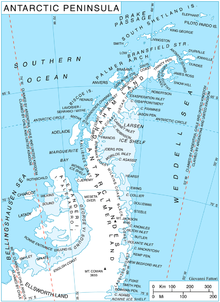John Rymill
John Riddoch Rymill (born March 13, 1905 in Penola , State of South Australia , † September 7, 1968 ibid) was an Australian polar explorer .
Life
Childhood and youth
Rymill was born in 1905 to the farmer Robert Rymill and his wife Mary Edith in Penola in southeast South Australia . The following year his father was killed in a car accident. Suffering from dyslexia, Rymill initially received home tuition and later went to school in Adelaide . From 1917 to 1922 he attended a Church of England school in Melbourne .
In 1927 he left for England, accompanied by his mother, where he first studied land surveying and navigation at the Royal Geographical Society , later deepened his knowledge at the Scott Polar Research Institute at the University of Cambridge and also obtained his license on the side.
First expeditions
1930-31 he took part in the British Arctic Air Route Expedition to Greenland under the direction of Gino Watkins (1907-1932). It was thanks to Rymill that a member of the expedition, Augustine Courtauld (1904–1959), was found and saved. In 1931 he covered with Wilfred Hampton (1907-1994) from Tasiilaq to Sisimiut about 640 km on the Greenland Ice Sheet .
In 1932 he undertook another expedition to the east coast of Greenland with Watkins and two other explorers. After Watkins drowned fishing in the Tugtilikfjord in August , Rymill took over the leadership of the expedition.
Expedition to Graham Land
Rymill organized an expedition to the Antarctic on his own . Despite great difficulties in finding donors during the economic crisis of the 1930s , he managed to put together an expedition to the west coast of the Antarctic continent . On September 10, 1934, he set sail on board the Penola from London towards Port Lockroy . On January 22, 1935, the expedition reached Port Lockroy and met with the British research vessel Discovery II , which was also carrying a single-engine De Havilland DH.83 Fox Moth in addition to other equipment . In the following years, the group built two bases, Antarctica explored by dogsled and the aircraft, pointing to that it is contrary to the presumption of Hubert Wilkins in Graham Land is not an island, but a part of the Antarctic Peninsula is. They also discovered George VI Sound , which separates Alexander I Island from the mainland. The expedition stayed in Antarctica until March 1937 and finally reached England on August 4th.
More years
After the expedition, Rymill received numerous awards. In addition to the British Polar Medal , for his exploration of the Arctic as well as the Antarctic, he received the Founder's Medal of the Royal Geographical Society and the David Livingstone Centenary Medal in Gold from the American Geographical Society (AGS). The AGS particularly praised the extensive, precise studies that were carried out during the expedition.
On September 16, 1938 Rymill married in England the geographer Eleanor Mary Francis (1911-2003), whom he knew from his time at the University of Cambridge. Both then moved to Penola and devoted themselves to agriculture. During World War II , Rymill served in the reserves of the Royal Australian Navy . Rymill later improved, in particular, the irrigation of his property and was a member of several agricultural and horticultural societies. Like his father, he died in 1968 at the age of 63 as a result of a car accident. He was buried in the Penola cemetery.
A bay , a coast and a cape in the British Antarctic Territory were named after him, as well as a summit of the Prince Charles Mountains in the Australian Antarctic Territory .
swell
- William J. Mills: Exploring Polar Frontiers: A Historical Encyclopedia. ABC-Clio, Santa Barbara 2003, ISBN 978-1-57607-422-0 , pp. 572ff.
- John Béchervaise: Rymill, John Riddoch (1905–1968) . In: Douglas Pike (Ed.): Australian Dictionary of Biography . Melbourne University Press, Carlton (Victoria) 1966–2012 (English).
Individual evidence
- ^ "The survey work of this expedition constitutes probably the largest contribution of accurate detailed surveys of the Antarctic Continent made by an expedition" (quoted from Australian Dictionary of Biography)
| personal data | |
|---|---|
| SURNAME | Rymill, John |
| ALTERNATIVE NAMES | Rymill, John Riddoch (full name) |
| BRIEF DESCRIPTION | Australian polar explorer |
| DATE OF BIRTH | March 13, 1905 |
| PLACE OF BIRTH | Penola , South Australia |
| DATE OF DEATH | 7th September 1968 |
| Place of death | Penola , South Australia |

